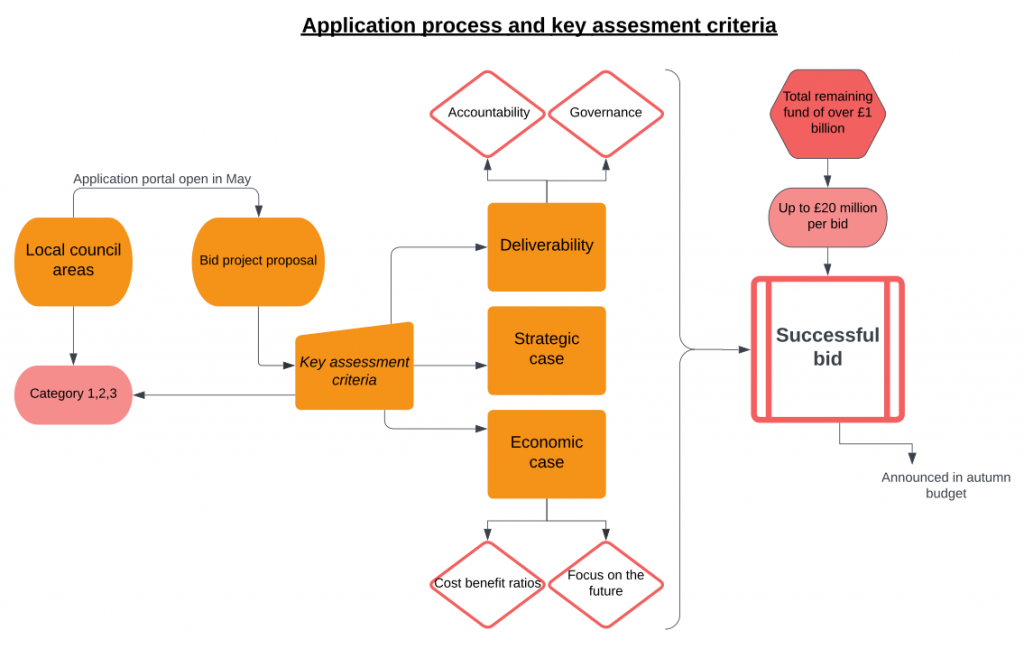Round 3 Levelling Up Fund Confirmation: How To Make A Successful Bid
As stated by the Chancellor in the Spring Budget announcement, ‘levelling up’ remains a key priority for this Government. In accordance with this ‘levelling up’ policy, Jeremy Hunt has confirmed a round three of the Levelling Up Fund. This will particularly look to help local authorities who have not found success in previous bids. Assuming project capital costs remain of a similar size, it is estimated there will be around 50 to 60 successful bids in round three. Each project can receive up to £20 million from the £1 billion remaining from the original £4.8 billion fund.
Inevitably, not every local authority can have a winning bid. In LUF round one, 36% of bids were successful, whereas, in round two, only 21% were successful. Within round 3, the increasingly limited availability of funds will lead to fierce competition and reward civic entrepreneurship. This reaffirms the importance of developing a strong submission to improve probability of success.
In order to create a strong submission, local authorities must first focus on the key government criteria. During round two of the Levelling Up Fund, the government prioritised investment in well-delivered bids which were assessed on four criteria: characteristics of place; strategic fit; deliverability; and the economic case, in line with the published assessment framework. More recently, there have been press reports that the Department of Levelling Up, Housing and Communities (DLUHC), has been prohibited from signing off any new capital expenditure without Treasury approval, hence there is likely to be increased analysis of both economic and strategic cases within round three. Therefore, the main priority of local authorities should be to deliver a strong underlying evidence base, supporting their cost-benefit ratios and the project’s overall economic benefits.
Local authorities have been categorised as priority 1, 2 or 3, with index category 1 representing areas with the highest level of identified need, based on government assessment metrics. The first two funding rounds largely provided funds to category 1 and 2 authorities. In round two, 66% of the 90 successful projects across England, Scotland and Wales were located within category 1 local authority areas, compared to 30% in category 2 areas. We believe that, just as in rounds one and two, bidders in round three from category 1 and 2 authorities, are most likely to be successful. Nonetheless, being in category 1 certainly does not mean automatic success: it remains equally important for category 1 areas to create forward-looking project proposals, underpinned by economic growth.
Project proposals should not just be a vision. To have the best chance of securing funding, local authorities must illustrate a clear roadmap for their project delivery over the timeframe. This delivery should clearly have a strong probability of success and achieve the Government’s 12 national levelling up missions, summarised in the table below. Of equal importance, project proposals must highlight the risks involved with delivery and, additionally, the mitigations in place for these risks.
To assist in the selection of a LUF project, it is important to first reconcile each potential project option back to the local authorities’ findings on problems and challenges within the area and where there is market failure. The impact of market intervention on the community and stakeholders, forms the basis of the business case and rationale for levelling up funding.
For round three, we have developed an option appraisal scorecard based on LUF monitoring and evaluation output indicators, and the investment themes: regeneration, culture and transport.
Importantly, we have linked the scorecard monitoring and evaluation output indicators to the Government’s levelling up missions, to assist local authorities identify their round three project/s, for developing into their bid.
| Output indicators | LUF mission |
| Mandatory | 1. Employment; growth of jobs (high quality) |
| 2. R&D; investment in innovation and skills trainings growth | |
| 12. Empowerment; improved local leadership | |
| Regeneration | 4. Broadband; 4 and 5 G roll out investment |
| 5. Education; key stage 2 performance improvements | |
| 6. Skills; high quality skills training course completions and growth | |
| 7. Health; increased life expectancy | |
| 10. Housing; first time buyer ownership growth | |
| 11. Community; reduction in neighbourhood crime | |
| Culture | 8. Wellness; improved life satisfaction |
| 9. Pride of Place; improved cultural assets | |
| Transport | 3. Public transport; service improvements |
We believe that round three will follow the target timeline of round two, where the application portal will remain open for a short time, approximately 10 weeks. On this basis, it is likely that the portal application will open in May and then close in the summer. It is expected that the announcement of successful bids will be in the Autumn Budget of this year. This short window means that it is essential for local authorities to be working up their bids now. Hence, the project appraisal methodology is useful to assist in focusing time and effort on the bid project that achieves a high benefit cost ratio.
Earth has successfully supported local authorities with securing funding and in LUF round two, supported Dover District Council in its successful bid, to win over £18 million for the ‘Dover Beacon’ project. We would be pleased to assist other local authorities in developing their bids for round three.
GET IN TOUCH

